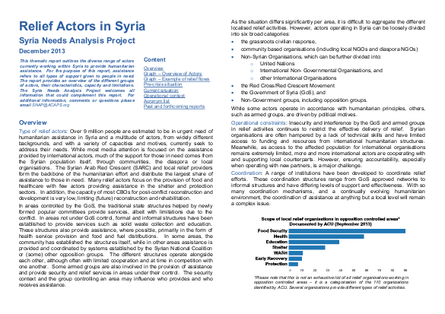
This thematic report outlines the diverse range of actors currently working within Syria to provide humanitarian assistance. For the purpose of this report, assistance refers to all types of support given to people in need. The report provides an overview of the different groups of actors, their characteristics, capacity and limitations. The Syria Needs Analysis Project welcomes all information that could complement this report.
Type of relief actors: Over 9 million people are estimated to be in urgent need of humanitarian assistance in Syria and a multitude of actors, from widely different backgrounds, and with a variety of capacities and motives, currently seek to address their needs. While most media attention is focused on the assistance provided by international actors, much of the support for those in need comes from the Syrian population itself, through communities, the diaspora or local organisations. The Syrian Arab Red Crescent (SARC) and local relief providers form the backbone of the humanitarian effort and distribute the largest share of assistance to those in need. Many relief actors focus on the provision of food and healthcare with few actors providing assistance in the shelter and protection sectors. In addition, the capacity of most CBOs for post-conflict reconstruction and development is very low, limiting (future) reconstruction and rehabilitation. In areas controlled by the GoS, the traditional state structures helped by newly formed popular committees provide services, albeit with limitations due to the conflict. In areas not under GoS control, formal and informal structures have been established to provide services such as solid waste collection and education. These structures also provide assistance, where possible, primarily in the form of health service provision and food and fuel distributions. In some areas, the community has established the structures itself, while in other areas assistance is provided and coordinated by systems established by the Syrian National Coalition or (some) other opposition groups. The different structures operate alongside each other, although often with limited cooperation and at time in competition with one another. Some armed groups are also involved in the provision of assistance and provide security and relief services in areas under their control. The security context and the group controlling an area may influence who provides and who receives assistance.